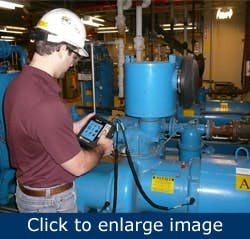Reducing maintenance cost, reducing production cost, improving uptime, reducing risk, improving safety, and improving product quality are some of the essential drivers for deploying vibration analysis and other predictive maintenance tools. They should be goals of any plant or corporation.
Vibration analysis and condition monitoring (CM) are important ingredients in all of these goals. Vibration analysis, if applied correctly, can provide identification of specific problems that routinely prevent these goals from being achieved. Furthermore, vibration analysis can be used as part of root cause analysis efforts within a facility. It is very important to identify what is causing specific problems to routinely occur and eliminate those causes.
Many considerations should be taken before and during the implementation of a vibration analysis program or any other CM technology. Some of them are commonly overlooked, but the best way to avoid obstacles that limit the success of vibration analysis and predictive maintenance programs is to take these 11 steps.
- Create a timeline.
- Get advice from others.
- Determine what training is required, budget for training from the beginning, and work with the vendor or other sources to provide the training.
- Determine which equipment should be monitored.
- Obtain the required equipment information to correctly build the technology database.
- Create equipment templates. This can greatly reduce the effort required to build the technology database, enforce standards and increase the analytical results provided.
- Dedicate appropriate resources. Do not implement a part time CM program.
- Identify what type of interface to other plant systems such as CMMS and control systems is required.
- Create standards. It is important to create standards for the implementation of the technology, analytical standards and reporting standards. A lack of standards leads to a lack of useful results.
- Get help. Management often considers hiring a consultant or the technology vendor to help implement the technology to be an unnecessary expense. This can be true in some cases. However, if done correctly, this type of service can provide needed training and get the technology providing results more quickly.
- Implement the results of the technology, such as repair requests and equipment modifications. Many CM programs provide little or no value, because the results of CM are not correctly implemented or implemented at all.
Complementary analysis
Figure 1. Vibration analysis complements other predictive maintenance tools.
Vibration analysis complements other predictive maintenance tools (Figure 1). It is important to take a four-phase approach with CM technologies when possible. Detect the problem with the appropriate technology, diagnose the issue (analysis of the results), confirm the problem when possible (use another complementary CM technology) and report the findings.
Vibration analysis can be used as part of the initial detection of a problem and confirmation of a problem found by many other CM technologies. For example, vibration analysis can be used for the identification and confirmation of many electrical defects and lubrication issues. Defects often generate signs that can be identified by multiple CM technologies. However, certain defects can only be identified by a certain CM technology such as vibration analysis. It is important to understand the limitations, benefits, and complementary aspects of each CM technology. This understanding will provide the greatest return on these technologies and the investments they require.
PdM for all
PdM solutions can be applied in some form to almost any machine or system that has rotating, electrical or lubricated components. Every facility and company will have assets that can benefit from the application of CM technologies. It is not a matter of whether CM can be applied, but a matter of how best to apply CM to obtain results.
The cost of doing nothing
Every business and every manager has to consider operating costs. However, most companies and managers don’t consider the cost of not implementing condition monitoring technologies. The cost of doing nothing may far exceed the cost of doing something.
For example, consider the cost savings associated with reducing the vibration levels on plant equipment. Simply reducing the overall vibration levels on a machine by 1% can increase the bearing life in the machine by as much as 3.4%. Reducing the overall vibration levels on equipment by 18% can double bearing life in your equipment. Consider the number of bearings being replaced in your plant each year. The savings could be substantial by implementing a vibration monitoring and analysis program and identifying ways to reduce the vibration levels on the equipment in your plant.
It’s important to understand what is causing the failures in your equipment. Not knowing the root causes of equipment failures will result in repeatedly making the same repairs over and over. Vibration analysis and other CM technologies can be used as a means to identify those root causes and eliminate them, resulting in fewer repairs and component replacements.
Document your failures
Securing funding for new technologies, additional employees, and services can be difficult. Consider documenting the cost of your equipment failures as a way to understand and justify the investment in condition monitoring technologies. Document the bearing failures, coupling failures, and equipment failures. Determine which condition monitoring technologies could have identified those failures and could have given your facility the opportunity to have taken corrective action.
Trent Phillips is condition monitoring manager at Ludeca (www.ludeca.com). Contact him at (305) 591-8935 or [email protected].

